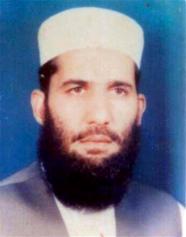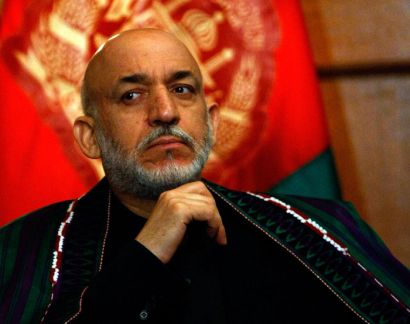Alex Constantine - April 9, 2010
By KATHY GANNON and ADAM GOLDMAN (AP)
 Gul Rahman died in the early hours of Nov. 20, 2002, after being shackled to a cold cement wall in a secret CIA prison in northern Kabul known as the Salt Pit, according to current and former U.S. officials familiar with the case. Rahman also once rescued Hamid Karzai, wading through rocket and small-arms fire to take the wounded future president to safety in Pakistan, according to his brother and former associates. (AP Photo/Habib Rahman, Ho)
Gul Rahman died in the early hours of Nov. 20, 2002, after being shackled to a cold cement wall in a secret CIA prison in northern Kabul known as the Salt Pit, according to current and former U.S. officials familiar with the case. Rahman also once rescued Hamid Karzai, wading through rocket and small-arms fire to take the wounded future president to safety in Pakistan, according to his brother and former associates. (AP Photo/Habib Rahman, Ho)
ISLAMABAD, Pakistan — The only prisoner known to have died in the CIA's network of secret prisons once rescued Hamid Karzai, wading through rocket and small-arms fire to take the wounded future president to safety in Pakistan, according to his brother and former associates.
The prisoner, Gul Rahman, died in the early hours of Nov. 20, 2002, after being shackled to a cold cement wall in a secret CIA prison in northern Kabul known as the Salt Pit, current and former U.S. officials familiar with the case confirmed. His family is appealing to the International Red Cross to return his body.
Rahman was captured about three weeks before his death in a raid in the Pakistani capital of Islamabad against Hezb-e-Islami, an Afghan insurgent group led by Gulbuddin Hekmatyar, which was believed to have ties to al-Qaida. Rahman was arrested along with Hekmatyar's son-in-law, Dr. Ghairat Baheer.
Baheer, who was later released, was part of a Hezb-e-Islami delegation that came to Kabul last month to talk peace with Karzai.
Rahman's brief association with the future Afghan president, reported by his brother Habib Rahman, adds an ironic twist to the account of his death at the hands of the CIA, and illustrates the complex history of the different Afghan factions still competing for power in this war-ravaged country.
After Soviet forces withdrew in 1989, Afghanistan descended into civil war as the Islamic groups that ousted the Soviets fought each other for control of the capital, Kabul.
During fighting in 1994, Karzai, then deputy foreign minister, was arrested by Afghan intelligence, by some accounts because he was in contact with Hekmatyar and other militia leaders to end the conflict.
Karzai himself has said little about his confinement except that he escaped when rockets struck the building where he was held and that he made his way to Pakistan.
The Associated Press contacted Karzai's spokesman, Waheed Omar, but he would not comment, although he said the president was aware of an AP story identifying Rahman as the victim of the CIA secret prison. Further requests for comment over the past week have also gotten no response.
According to Habib Rahman, his brother, Gul Rahman was sent to fetch Karzai by Hekmatyar, whose forces had long been suspected of firing the rockets at the building. Gul Rahman carried a letter for Karzai from Hekmatyar, saying he had been sent to rescue him at the request of Karzai's father, the brother said.
Habib Rahman said his brother took Karzai to a safe house in Kabul, then drove with him to the Pakistani city of Peshawar, where Karzai was hospitalized for two days.
Although Karzai has not confirmed Rahman's role, Hekmatyar spoke about it in an interview last year with the Afghan Pashto language Web site Benawa.com. Hekmatyar complained that Karzai had promised to release those who helped him "but look, Gul Rahman is still not released but Karzai is president." The whereabouts of his body are unknown.
Sam Zarifi, who was part of a Human Rights Watch investigation into the rocket attacks of the early '90s, said he believed the version provided by Gul Rahman's brother was "an utterly plausible story."
"How Karzai got out of Kabul and through the front lines to Peshawar was always mysterious to us," said Zarifi, who now works for Amnesty International. "We always just wondered as to how he did that. That was the question for us: Unless he had high level contact, how did he get through these front lines?"
The AP interviewed Habib Rahman in Islamabad, at the home of Hekmatyar's son-in-law that was raided in 2002.
Habib Rahman said his brother had come to Islamabad a day before the Oct. 29, 2002 raid for a medical checkup for his allergies and was planning to return the next day to the Shamshatoo refugee camp near Peshawar, where he lived with his wife and four daughters and sold wood.
He said the agents surrounded the marble-fronted house at 1:30 a.m., arresting Rahman and four others. Hekmatyar's son-in-law, Baheer, spent six years in the U.S. detention center at Bagram Air Field and six months in the Salt Pit. He told The AP earlier he was stripped naked and shackled. Occasionally his interrogators would put a chair on his exposed belly and sit on it.
"At the beginning they (Americans) were like animals, they were so angry, they just wanted revenge" for 9/11, Baheer's son, Abdullah Baheer, said. "Now we think it has changed, but then they were so cruel."
After Gul Rahman froze to death, the agency moved to improve its interrogation procedures.
No one was ever charged in Rahman's death, including the agency officer who ran the secret prison. The U.S. Justice Department is now conducting its third review of the case, investigating Gul Rahman's death and a small number of other CIA cases.
Last week, the FBI rejected a Freedom of Information Act request the Associated Press submitted for autopsy records in the death, saying it was relevant to "a pending or prospective law enforcement proceeding."
Last week was also when Habib Rahman learned of his brother's final hours, hanging half-naked in a cold, dark cell.
"It must have been horrific for him. I don't know how he suffered. You know he could never take the cold. He always hated it," he said. He picked up a carefully folded shawl and wiped his tears. In a red booklet in his pocket were two small pictures of Gul Rahman.
"We want his body back. We want them to let us give him a religious burial," he said. "We will ask the Red Cross and the Americans to return his remains to us."
He has assumed responsibility for his brother's family; the eldest daughter, Hajra is 17 and finishing high school. Her sisters are Abida, 15, Fawzia, 13 and Asma, 9.
"I am the head of the family and responsible for everyone in our family. I have tried to look after them," Rahman said. "It has been difficult but all of them are in school."
http://www.google.com/hostednews/ap/article/ALeqM5ju1N_iEisP0uQwzfnPAwYx5VNWBwD9ETVPBG0





